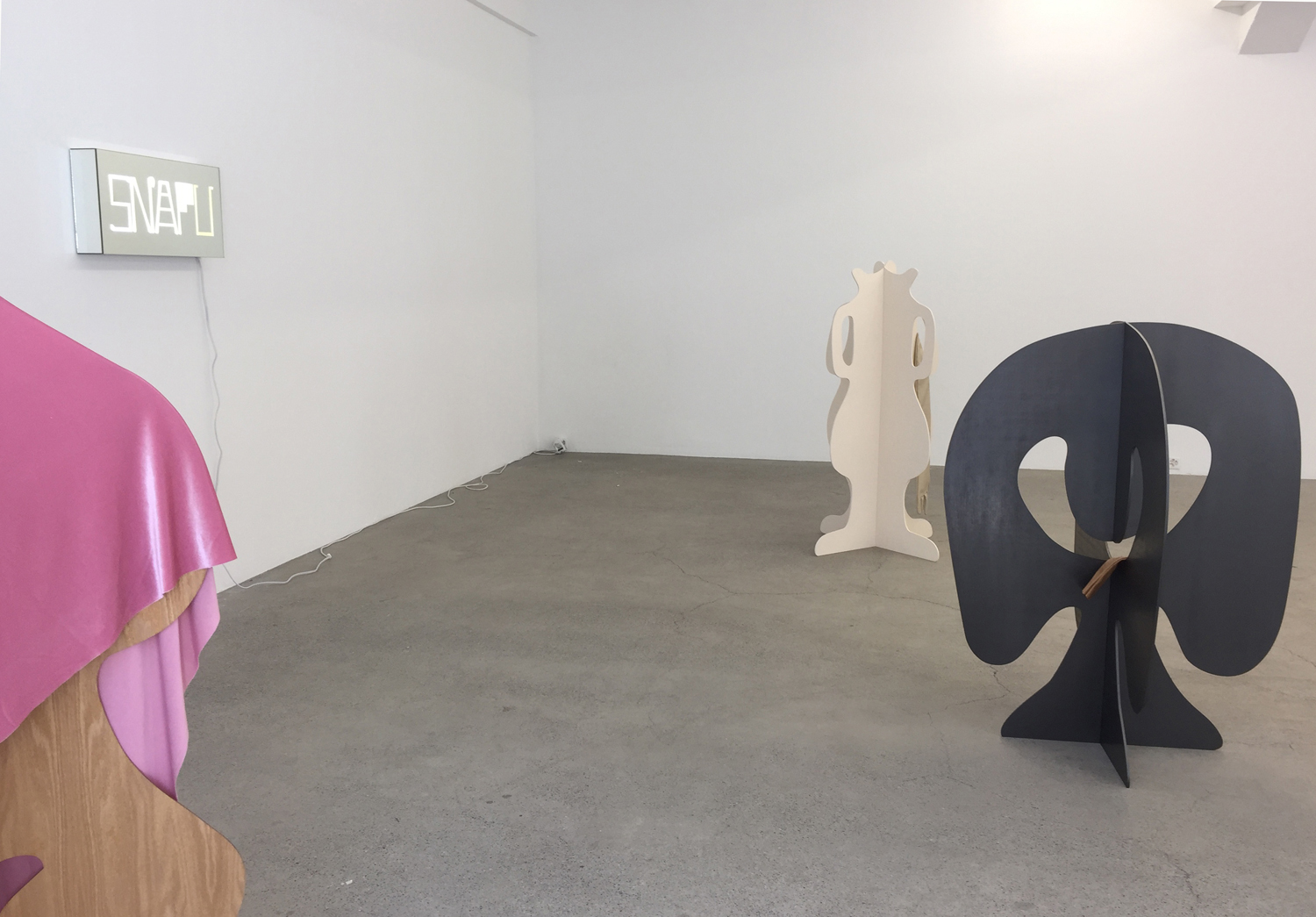

















SNAFU!
Barbara Seiler Galerie
Zurich, Switzerland
June 9 – July 16, 2017
Link ->
Snafu
sna-ˈfü, ˈsna-ˌfü
noun
1. A badly confused or ridiculously muddled situation: A ballot snafu in the election led to a recount.
Origin: (military, slang, euphemistic) Acronym of status nominal all fucked up or situation normal all fucked up (fouled up)
~~~~~~
They went into the salon.
It was a boudoir hung in old rose crepe, a soft material, garlanded with Bengal lights of Venetian glass which lit up as soon as they crossed the threshold. The furniture seemed fragile, also of crystal. Among the strange knickknacks of Japanese complication or Chinese tortuousness, there was one admirable objet d’art placed in the middle of the room on a pedestal of old rose velvet, like an altar; an alabaster vase the height of a man, so slim, so slender, so deliciously troubling with its ephebe’s hips, with such a human appearance, even though it retained the traditional shape of an amphora, that the viewer remained somewhat speechless, The foot, very narrow, like a spear of hyacinth, surged up from a flat and oval base, narrowed as it rose, swelled, at mid-height, to the size of two beautiful young thighs hermetically joined and tapered off towards the neck where, in the hollow of the throat, an alabaster collar shone like a fold of plump flesh, and, higher up, it opened out, spreading into a corolla of white, pure, pale convolvulus, almost aromatic since the white, smooth material with it’s milky transparence had such lifelike sincerity. This neck spreading into a corolla made one thing of an absent head, a head city off or carried on shoulders other than those of the amphora.
“What a marvel!” cried Leon, completely seduced by this apparition of the adorable chastity of line. “Isn’t it beautiful! Isn’t he beautiful,” continued Eliante feverishly…
— Rachilde, The Juggler, first published in 1900. Translation Melanie C. Hawthorne, 1990, Rutgers University Press, pg 18.
~~~~~~
Shana Lutker’s psychedelic forest of “urns” installed in the gallery grow from this passage in Madame Rachilde’s controversial novel of 1900, The Juggler in which the amphora attains an elevated status. The beloved object becomes love object. The protagonist Eliante elides her young suitor Leon’s advances, satisfied by her urn, and no need for physical touch of another human. The urn is it. Constructed in a range of materials, Lutker’s sculptures are bad objects—the fools, the jesters, the leftovers. Where’s the alabaster urn of perfection? Not here. The viewer instead is left to navigate through the installation of mischievous sculptures, urn imposters. Simply comprised of intersecting planes, frozen in between two and three dimensions, the objects also both flat and fat. They are simultaneously abstract and full of personality. Lutker doesn’t try to recreate or represent the elaborate display of Eliante’s boudoir, she strips it down to the barest elements, a skeleton that smells of decadence.
The flashing mirror light boxes serve to alert us to the obvious: there’s been a SNAFU! This is another case of “situation normal all fucked up.” There’s a SNAFU epidemic. And the word “SNAFU” seems apt, not only in our current political climate, but also as a description of Eliante’s preoccupation with her object. Things are normal and all fucked up, at the same time. And further, in the context of the artist’s ongoing body of work, the installation serves as another set of stand-ins, for the Surrealists in action. Rachilde figures prominently in one of the fistfight of the Surrealists that is focus of Lutker’s work, at the Closerie de Lilas in Paris in 1925. For this exhibition, Lutker pauses to focus on Rachilde, a remarkable figure whose novels were groundbreaking in depicting gender-bending love stories and independent women.
This exhibition at Barbara Seiler Galerie is Lutker's fourth solo exhibition and serves as an appendix to the fourth chapter in Lutker's eight-part body of work titled Le "NEW" Monocle: The History of the Fistfights of the Surrealists. For the past years, Lutker has been compiling the history of the fistfights of the Surrealists, visiting the sites across Paris where these took place, and delving into archives. These altercations highlight the conviction, absurdity, passion and calculation of this avant-garde group, and raise questions about the way that passion and art combine today.
Work from the History of the Fistfights of the Surrealists has been exhibited at the gallery, as well as the Pérez Art Museum Miami, the Hirshhorn Sculpture Garden and Museum in Washington D.C., Hauser & Wirth New York and Los Angeles, Susanne Vielmetter Projects Los Angeles, the Whitney Biennial 2014 and Performa 13, New York.